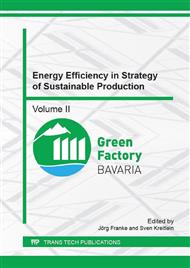[1]
M. M. Farag, Quantitative methods of materials substitution: Application to automotive components, Materials and Design 29, 374-380, (2008).
DOI: 10.1016/j.matdes.2007.01.028
Google Scholar
[2]
R. V. Rao, A decision making methodology for material selection using an improved compromise ranking method, Materials and Design 29, 1949-1954, (2008).
DOI: 10.1016/j.matdes.2008.04.019
Google Scholar
[3]
T. W. Liao, A fuzzs multicriteria decision-making method for material selection, J Manuf Syst, 15, 1996, pp.1-12.
Google Scholar
[4]
M. F. Ashby, Y. J. M. Brechet, D. Cebon, L. Salvo, Selection strategies for materials and processes, Mater Design, 25: 51-67, (2004).
DOI: 10.1016/s0261-3069(03)00159-6
Google Scholar
[5]
J. Jahn, M. Weeber, J. Boehner et al., Assessment strategies for composite-metal joining technologies – a review, 26th CIRP Design Conference: Creative Design of Products and Production Systems. Paris: CIRP, 2016, 6 S.
DOI: 10.1016/j.procir.2016.05.034
Google Scholar
[6]
I. Reichel: ILK Aktuell 02/2015. ILK – Institute of Lightweight Engineering and Polymer Technology o the Technical University of Dresden, (2015).
Google Scholar
[7]
A. Barroso, D. Vicentini, F. París et al., Representatively of thermal stresses in designing composite joints based on singular stress states at multi material corners. Composites Part A: Applied Science and Manufacturing 42, 9, 2011, p.1084–1092.
DOI: 10.1016/j.compositesa.2011.04.013
Google Scholar
[8]
S. -H. Lee, C. -J. Lee, K. -H. Lee et al., Influence of Tool Shape on Hole Clinching for Carbon Fiber-Reinforced Plastic and SPRC440, Advances in Mechanical Engineering 6, 0, 810864 (2014).
DOI: 10.1155/2014/810864
Google Scholar
[9]
T. Löbel, B. Kolesnikov, S. Scheffler et al., Enhanced tensile strength of composite joints by using staple-like pins, Composite Structures 106, 2013, p.453–460.
DOI: 10.1016/j.compstruct.2013.06.020
Google Scholar
[10]
P. N. Parkes, R. Butler, J. Meyer, A. Oliveira, Static strength of metal-composite joints with penetrative reinforcement, Composite Structures 118, 2014, p.250–256.
DOI: 10.1016/j.compstruct.2014.07.019
Google Scholar
[11]
Landesbetrieb für Forst- und Domänenverwaltung, Available at http: /www. provinz. bz. it/forst/landesbetrieb/landesforstgarten-versuche. asp, cited 08. 02. (2016).
Google Scholar
[12]
J. Grossmann, Das Holz als Rohstoff, Vieweg+Teubner, Wiesbaden, (1922).
Google Scholar
[13]
M. Klein, B. Thorenz, C. Lehmann et al., Integrating new technologies and materials by reengineering: selected case study results, 26th CIRP Design Conference, (2016).
DOI: 10.1016/j.procir.2016.05.009
Google Scholar


